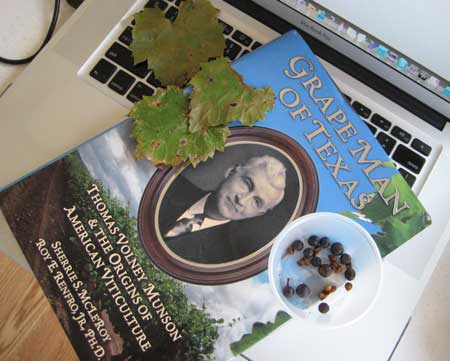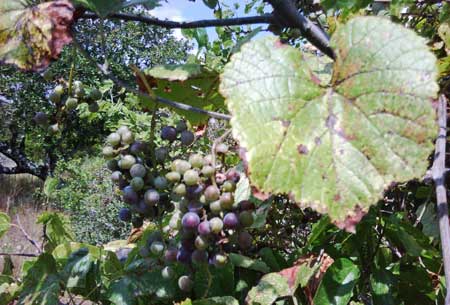
Discovering the T.V. Munson Texas-French Grape Legacy on My Own North Forty
Some of you may know T.V. Munson, The Grape Man of Texas. He is the horticulturalist/viticulturalist from Texas that correctly identified Texas native vine stock as highly disease resistant and provided it to vineyards in France to use as rootstock in their fight against the Phylloxera infestation in the late 1800s.
If you have been following the wine-banter here on VintageTexas or on the Texas Winegrowers list serve on Yahoo or even that in the Lubbock newspaper, you have to know that 2010 is a banner year for growing wine grapes in Texas. I have even gone so far as to proclaim it, “The Vintage of the Century” (https://vintagetexas.com/?p=2250).
Well, the same seems to be the case here on our portion of the Alamo Springs Ranch (http://alamospringsranch.com) in the Texas Hill Country. Yesterday, at our cottage on the Big Hill, it was simply a delightful day with an almost crisp morning in the low sixties. As I walked down the north slope of our property, I was amazed by the lush growth of both canopy and fruit on the wild grape vines, but most of the fruit from about 4 feet down was eaten by our diminutive local deer. Jerry Watson, who grows wine grapes down in Cat Spring, recently told me something (See: Texas Gulf Coast Wine Country – Old Place, New Opportunity https://vintagetexas.com/?p=1412).
He said, “Ya’ know, deer are foragers, they only eat what they see below them. They never look up. The high cordon system that I use in my vineyard hangs its fruit up around 54 inches, above where the deer eat, or even look.” This seems to be the case here, too.
The grapes that cohabitate on my property are not what most people in Texas refer to as Mustang grapes (Vitis Candicans) that have the large round free-hanging berries and the large umbrella shaped leaves. I came to realize yesterday that I really didn’t know what type of grapes they actually were. The grapevines down the hill, what I call my “north forty”, have smaller, pointy-lobed leaves and support clusters of petite grape berries, each about the size of a pea. Each berry has four seeds that occupy most of the inner volume of the grape. No wonder they aren’t commercial for wine making. Even it they tasted like the best Cabernet, you would have to crush about ten tons of them to get a single bottle of wine.
Recently, I was at the wine quality boot camp at Grayson College in Denison, Texas, and met with Roy Renfro who is the world’s expert on all things Munson (See: Traveling the Wine Roads of Northeast Texas Wine Country and the Grape Man of Texas https://vintagetexas.com/?p=1995).
We talked about Munson’s legacy as Roy took me on a tour of Munson’s home, Vinita and I walked and ate my way through the Munson Memorial Vineyard. Before leaving, he provided me with a copy of the new version of his book on Munson titled, “The Grape Man of Texas” and a newly printed version of Munson’s book, “Foundations of American Grape Culture” that was originally published by Munson in 1909.
Between the descriptions and photographs presented in the two Munson books, I feel comfortable saying that the grapevines on my property belong to the category, Vitis Cinerea. Vitis Cinerea has small black berries that are mildly tart with only a hint of sweetness even when fully ripe. They leave a sensation of dryness (tannin) in the mouth and a slight acidic burning sensation on the lips.
I was originally surprised to find many green grapes yet to ripen despite the blisteringly hot days we have had this year. It appears that the vines on the north side of the hill have mostly green, unripe grapes, whereas the grapes on vines facing more southerly have ripe, black grapes. Vitis Cinerea is also know by the name “Winter Grape” that suggests that it is a late ripening grape, which was the case here.

The most common native grape varieties found in Texas are: Post Oak (Vitis Lincecumii), Mustang (Vitis Candicans), Sour Winter (Vitis Cordifolia), Sweet Winter (Vitis Cinerea), Sand (Vitis Rupestris), Riverside (Vitis Riparia), and Fall Grape (Vitis Berlandieri).
Interestingly enough, Vitis Cinerea was one of three varieties of wild grapes from Texas that Munson sent to France (Vitis Berlandieri, Vitis Cinerea and Vitis Cordifolia) to address their Phylloxera infestation. This in itself this was not surprising, because many viticulturalists back then were sending samples of native grapes to France from all over the United States. However, most vinestock provided from American sources unexpectedly died once planted in French soil.
One of Munson’s key understandings and contributions to solving the Phloxerra problem in France was in recognizing that, of all areas of the United States, Central Texas has the soils that have the most in common with those of the winegrowing areas of France. However, still to this day, most people in the vast American society of wine drinkers and aficionados do not know this very important fact when considering Texas as a new emerging winegrowing region. They merely, think of Texas in terms of the last John Wayne movie they saw many years ago.
Both Texas and France are founded on generous helpings of Late Cretaceous limestone. They are both known for their high outcroppings of limestone, under beds of porous nodular limestone (called caliche here in Texas) and “limey” soils of high pH. After getting to France, many of the other varieties of American grapes that came from Missouri, Pennsylvania and New England suffered badly from Chlorosis and other diseases. In contrast, the native Texas grapes sent to France found soils much to their liking, very similar to those that they enjoyed back home in Texas.
Yesterday, it was an interesting day on Alamo Springs Ranch. I learned something new, something unexpected, and something that put me even closer to the Munson legacy, right here on my own north forty. Let’s make a toast to Munson, the Grape Man of Texas! Long before anyone else did, he recognized the logical connection between the vineyards of France and the vineyards, in his time, that were yet planted in Texas.
— — — — —
More on T.V. Munson, The Munson Center and Memorical Vineyard and Roy Renfro’s book at:
http://en.wikipedia.org/wiki/Thomas_Volney_Munson
http://www.amazon.com/Grape-Man-Texas-American-Viticulture/dp/1934259047

Great article Russ. I’m curious, though, about the source of your information about rootstocks to France. “…three varieties of wild grapes from Texas that Munson sent to France (Vitis Berlandieri, Vitis Cinerea and Vitis Cordifolia) …”. Does the source say when, and to whom, Munson sent his cuttings? I’m particularly curious about V. berlandieri, because so many of today’s rootstock varieties have this background.